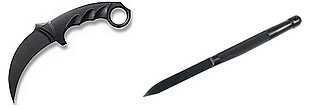Personal Defense Knives
How to Choose Personal Defense Knives
If you search the web for personal defense knives, buckle up and hold on. Just about every knife manufacturer claims theirs is the best. To decide what personal defense knives work for you, you should determine a few things first.
Knife Type
For the sake of argument, let’s focus on fixed blade and folding knife blades. I have seen the Out the Front (OTF) knives that extend the blade out the front of the knife and the covert ops knives that actually shoot the knife blade out of the handle like a projectile. They are not your normal type of knife so I will leave them out of this post.
Design
Folding blade knives allow the blade to be closed and stored in the handle. Depending on the knife design, the blade can be exposed with a flick of the wrist, use a thumb lug or a spring to help you open the blade. The blade locks into place and remains exposed until you return it into the handle. Folding knives are easily concealable, easy to carry but have shorter blades.
Fixed blade knives are basically a solid chunk of material, sharp on one end, a handle on the other. They are usually longer than folding knives and usually come with a sheath to house the blade so you can carry them without cutting yourself. Due to the length of some of the fixed blade personal defense knives being 8 inches in length and longer, it could be a problem when it comes to concealment.
Blade Length
The longer the blade, the easier it is to stab or cut your attacker before they can get to you. Because fixed blades are usually longer than folding knives, you can keep your attacker further away.
Smaller folding knives have shorter blades allowing your attacker to move in closer to you. Their blades usually average 3 to 4.5 inches in length.
Check your state laws to determine the maximum blade length for fixed and folding knives.
Blade Design
Tanto blades have been modeled after the Japanese tanto sword. They have an upper facing point, and usually have two beveled edges. This makes the blade very strong. Most tanto blades are sharpened on one edge but if you look around, some are sharpened on both sides of the blade.
Drop point blades are very popular. There are numerous variations but the blade has a convex drop in its point but goes to the blade’s full width after a half inch or so. There is a very good chance you have seen this knife design. There are also clip point, spear point, needle point, etc. If you’re interested in seeing all of the blade types, a quick search of the web will satisfy your curiosity.
Blade Materials
Ceramic knife blades are usually made out of a very hard and tough zirconia material. They really hold an edge but the issue is re-sharpening the blade. Ceramic blades rank at above 8 on the mineral hardness scale where stainless steel is 6 or so. Because of their hardness, they have to be re-sharpened using a diamond coated grinding stone.
Stainless Steel blades are very popular but there are different grades of steel used to make the blades. 440C is a high chromium stainless steel that holds a good edge, has resistance to corrosion and it’s easy to re-sharpen. Keep in mind this is one of many types of stainless steel that is used to make knife blades.
A Damascus blade is a work of art. The steel has been folded over and forged, again and again. The blades are very tough and really hold an edge. The blade is acid etched to expose the layers of steel, creating an incredible layered look that’s unique to each blade. If this sounds expensive, it is. Not one of your practical day-to-day personal defense knives but they sure look cool.
Polymer personal defense knives are made out of a high-tech polymer plastic used to produce hand gun frames such as Glock, Kel-Tec, Ruger, Springfield, etc. They’re very light weight (usually starting at one ounce) can be molded into just about any shape you can think of. Some are fixed blades, others have folding blades. They’re not designed to be a day-to-day knife. They’re designed to be a back up personal defense knife. They have also turned into a collectible item due to their low cost and their sometimes unique design. They can be sharpened with an emery board nail file.
As you have just read, there is a lot to be considered in selecting one or more personal defense knives.



